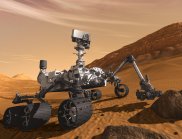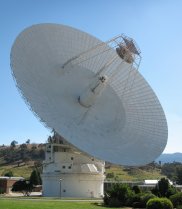Australia is “all ears” for Mars landing
Dishes in Australia will be the ones following NASA’s Mars Science Laboratory mission when it lands on Monday (6 August) after a nail-biting series of manoeuvres.
The Canberra Deep Space Communication Complex (CDSCC), which CSIRO manages on NASA’s behalf, will be the main tracking station for landing activities. Its 70-m and two 34-m antennas will receive signals from the spacecraft both directly and then relayed through another NASA spacecraft, Mars Odyssey, which is already in orbit around the red planet.
“The expertise of Australian personnel in space communications and CSIRO’s partnership with NASA will be showcased during this critical event in the Mars Science Laboratory’s mission”
Dr Phil Diamond, Chief, CSIRO Astronomy and Space Science
CSIRO’s 64-m Parkes telescope will record signals directly from the spacecraft as a backup in case there is a problem with the relaying. But as the spacecraft descends, it will drop below the Martian horizon (and out of direct sight of Earth-based antennas) about two minutes before touchdown, and Parkes will cease receiving its signals.
“The expertise of Australian personnel in space communications and CSIRO’s partnership with NASA will be showcased during this critical event in the Mars Science Laboratory’s mission,” says Chief of CSIRO Astronomy and Space Science, Dr Phil Diamond. “All of our technology and our people are ready.”
A third, smaller, antenna managed by the European Space Agency (ESA) at New Norcia near Perth in WA will provide extra redundancy. It will receive signals from the spacecraft recorded and re-sent through ESA’s Mars Express satellite, which is in orbit around Mars.
Signals from the Canberra station will be sent directly to mission scientists at NASA’s Jet Propulsion Laboratory (JPL) in Pasadena, California. Data from Parkes and New Norcia will be sent later for analysis.
The spacecraft will slam into the atmosphere at 20 000 km per hour. Over the next seven minutes the craft and then its payload must be slowed to essentially zero.
The landing has several stages: cruise, deployment of the entry capsule and then the parachute, separation of the heat shield, and finally the operation of the “skycrane” that is to lower the 900-kg rover, Curiosity, onto the Martian surface.
As each stage is successfully completed the spacecraft will send a unique tone indicating that it has occurred.
During the landing, the mission scientists can only watch and wait. They call this time the “seven minutes of terror”.
The exact landing time for the spacecraft is determined by several factors, including descent time on the parachute, Martian winds, and any variation how the spacecraft flies under power before the landing. Confirmation of a touchdown signal could be received on Earth at 3.31 pm AEST at the earliest.
Winds could mean that descent time on the parachute is longer, but at this time of year on Mars the weather is very stable and is not expected to cause any problems.
If the final set of tones is not heard, Mars Odyssey will listen for them again when it orbits over the landing site 1.5 hours later.
The landing is completely pre-programmed: it cannot be controlled from Earth because of the time that it takes to send a radio signal to Mars and then receive a response on Earth (about 14 minutes each way). The last opportunity to send the spacecraft any commands will be two hours before it enters the atmosphere. “After that, it’s on its own,” said Glen Nagle, Public Outreach Manager at the Canberra Deep Space Communication Complex.
Media resources
Click image for high resolution version.


